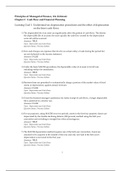Principles of Managerial Finance, 12e (Gitman)
Chapter 3 Cash Flow and Financial Planning
Learning Goal 1: Understand tax depreciation procedures and the effect of depreciation
on the firm's cash flows.
1) The depreciable life of an asset can significantly affect the pattern of cash flows. The shorter
the depreciable life of an asset, the more quickly the cash flow created by the depreciation
write-off will be received.
Answer: TRUE
Topic: Depreciation and Cash Flows
Question Status: Previous Edition
2) Non-cash charges are expenses that involve an actual outlay of cash during the period but
are not deducted on the income statement.
Answer: FALSE
Topic: Depreciation and Cash Flows
Question Status: Previous Edition
3) Under the basic MACRS procedures, the depreciable value of an asset is its full cost,
including outlays for installation.
Answer: TRUE
Topic: Depreciation and Cash Flows
Question Status: Previous Edition
4) Business firms are permitted to systematically charge a portion of the market value of fixed
assets, as depreciation, against annual revenues.
Answer: FALSE
Topic: Depreciation and Cash Flows
Question Status: Previous Edition
5) Given the financial manager's preference for faster receipt of cash flows, a longer depreciable
life is preferred to a shorter one.
Answer: FALSE
Topic: Depreciation and Cash Flows
Question Status: Previous Edition
6) For tax purposes, using MACRS recovery periods, assets in the first four property classes are
depreciated by the double-declining balance (200 percent) method using the half-year
convention and switching to straight line when advantageous.
Answer: TRUE
Topic: Depreciation and Cash Flows
Question Status: Previous Edition
7) The MACRS depreciation method requires use of the half-year convention. Assets are
assumed to be acquired in the middle of the year and only one-half of the first year's
depreciation is recovered in the first year.
Answer: TRUE
Topic: Depreciation and Cash Flows
Question Status: Previous Edition
1
, 8) Allocation of the historic costs of fixed assets against the annual revenue they generate is
called
A) net profits.
B) gross profits.
C) depreciation.
D) amortization.
Answer: C
Topic: Depreciation and Cash Flows
Question Status: Previous Edition
9) The Modified Accelerated Cost Recovery System (MACRS) is a depreciation method used
for ________ purposes.
A) tax
B) financial reporting
C) managerial
D) cost accounting
Answer: A
Topic: Depreciation and Cash Flows
Question Status: Previous Edition
10) A corporation
A) must use the same depreciation method for tax and financial reporting purposes.
B) must use different depreciation methods for tax and financial reporting purposes.
C) may use different depreciation methods for tax and financial reporting purposes.
D) must use different (than for tax purposes), but strictly mandated, depreciation methods
for financial reporting purposes.
Answer: C
Topic: Depreciation and Cash Flows
Question Status: Previous Edition
11) The depreciable value of an asset, under MACRS, is
A) the original cost (purchase price) only.
B) the original cost minus salvage value.
C) the original cost plus installation.
D) the original cost plus installation costs, minus salvage value.
Answer: C
Topic: Depreciation and Cash Flows
Question Status: Previous Edition
12) Under MACRS, an asset which originally cost $10,000 is being depreciated using a 5-year
normal recovery period. What is the depreciation expense in year 3?
A) $1,900
B) $1,200
C) $1,500
D) $2,100
Answer: A
Topic: Depreciation and Cash Flows
Question Status: Previous Edition
2
,13) Under MACRS, an asset which originally cost $100,000 is being depreciated using a 10-year
normal recovery period. The depreciation expense in year 5 is ________.
A) $10,000
B) $12,000
C) $21,000
D) $ 9,000
Answer: D
Topic: Depreciation and Cash Flows
Question Status: Previous Edition
14) Under MACRS, an asset which originally cost $100,000 is being depreciated using a 10-year
normal recovery period. The depreciation expense in year 11 is ________.
A) $3,000
B) $4,000
C) $0
D) $6,000
Answer: B
Topic: Depreciation and Cash Flows
Question Status: Previous Edition
15) Given the financial manager's preference for faster receipt of cash flows,
A) a longer depreciable life is preferred to a shorter one.
B) a shorter depreciable life is preferred to a longer one.
C) the manager is not concerned with depreciable lives, because depreciation is a non-
cash expense.
D) the manager is not concerned with depreciable lives, because once purchased,
depreciation is considered a sunk cost.
Answer: B
Topic: Depreciation and Cash Flows
Question Status: Previous Edition
16) The depreciable life of an asset is of concern to the financial manager. In general,
A) a longer depreciable life is preferred, because it will result in a faster receipt of cash
flows.
B) a shorter depreciable life is preferred, because it will result in a faster receipt of cash
flows.
C) a shorter depreciable life is preferred, because management can then purchase new
assets, as the old assets are written off.
D) a longer depreciable life is preferred, because management can postpone purchasing
new assets, since the old assets still have a useful life.
Answer: B
Topic: Depreciation and Cash Flows
Question Status: Previous Edition
3
, 17) The depreciable value of an asset, under MACRS, is
A) the full cost excluding installation costs.
B) the full cost minus salvage value.
C) the full cost including installation costs.
D) the full cost including installation costs adjusted for the salvage value.
Answer: C
Topic: Depreciation and Cash Flows
Question Status: Previous Edition
18) Under MACRS, an asset which originally cost $100,000, incurred installation costs of $10,000,
and has an estimated salvage value of $25,000, is being depreciated using a 5-year normal
recovery period. What is the depreciation expense in year 1?
A) $15,000
B) $12,750
C) $11,250
D) $22,000
Answer: D
Topic: Depreciation and Cash Flows
Question Status: Previous Edition
19) Darling Paper Container, Inc. purchased several machines at a total cost of $300,000. The
installation cost for this equipment was $25,000. The firm plans to depreciate the equipment
using the MACRS 5-year normal recovery period. Prepare a depreciation schedule showing
the depreciation expense for each year.
Answer: Depreciation Schedule
Topic: Depreciation and Cash Flows
Question Status: Previous Edition
Learning Goal 2: Discuss the firm's statement of cash flows, operating cash flow, and
free cash flow.
1) Free cash flow (FCF) is the cash flow a firm generates from its normal operations; calculated
as EBIT - taxes + depreciation.
Answer: FALSE
Topic: Free Cash Flow
Question Status: Previous Edition
2) The finance definition of operating cash flow excludes interest as an operating flow.
Answer: TRUE
Topic: Operating Cash Flow
Question Status: Previous Edition
4





